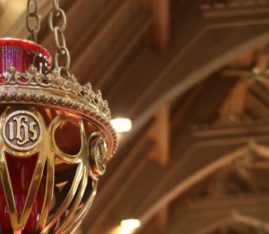How did “the Lutherans” come about? The Augustinian friar named Martin Luther questioned non-biblical teachings and practices that had crept into the Church. Among these was earning God’s favor as agents of our own salvation. Luther rejected indulgences, meriting forgiveness, and other errors. He returned to God’s word as the font of the faith affirming that the heart of Christianity is “In Christ, God was reconciling the world to Himself, not counting (their) trespasses against them” (2 Corinthians 5:19).
In order to debate his faith-questions, Brother Martin posted 95 statements on a cathedral door in Wittenberg, Germany in 1517. He asked for a return to what the Church always taught. Sinners are saved by grace through faith and not by themselves (Ephesians 2:5f.).
His document ignited a fire storm. Luther’s reliance on Scripture not only put his life in danger, it catalyzed huge religious and social upheaval. In 1523, Charles the Fifth, emperor over much of Europe, called the German princes to explain their beliefs. They made their confession in Augsburg, outlining the whole Christian faith. They hoped for reform. Instead, over the next 50 years, Lutherans were attacked, exiled, executed and endured. As a mark of unity in the face of opposition, they wrote confessions stating what they believed. In 1580 these confessions were assembled as the Book of Concord. Lutherans have historically been a confessing church, embracing the authority of Scripture and the centrality of Christ. They have also held that the Book of Concord is an accurate explanation of Scripture.
After the Reformers made their dangerous confession in 1523, Lutherans endured many external trials. More often the danger was from within. Over the centuries, each generation has been tempted to re-invent God according to the values of the day, such as Pietism, Rationalism, Romanticism, Pragmatism, Existentialism, Nihilism and Post Modernism. However, Luther’s famous “Here I Stand” remains true. We believe in the Bible as written and to what it says of Jesus Christ. Scripture is a faithful witness that reveals the God who is, and who we are before God.
Lutherans arrived in North America during the 1600’s as a religious minority. They first came among the Dutch and then the Swedes. German Lutherans were organized by Henry Muhlenburg in the mid 1700’s. During the massive immigration in the 1800’s thousands of new Lutheran churches formed associations called synods (which means walking together). Church fellowship was formed by shared language and/or common confessions. The newly formed synods funded schools, universities, seminaries, missions, and mercy-care. Generally, synods were tied to one of two theological poles: retaining the historic Lutheran Confessions or interpreting the Confessions by the norm of culture. The German Evangelical Lutheran Synod of Missouri, Ohio, and Other States was formed in 1847, shortening its name to The Lutheran Church – Missouri Synod on the occasion of its 100th anniversary in 1947. It professes that the word of Christ remains the same for all generations. Today the major Lutheran synods in the USA are the Evangelical Lutheran Church in America (ELCA – 3.6 million members), the Lutheran Church – Missouri Synod (LC-MS – 2.1 million), and the Wisconsin Synod (WELS, 360,000).
